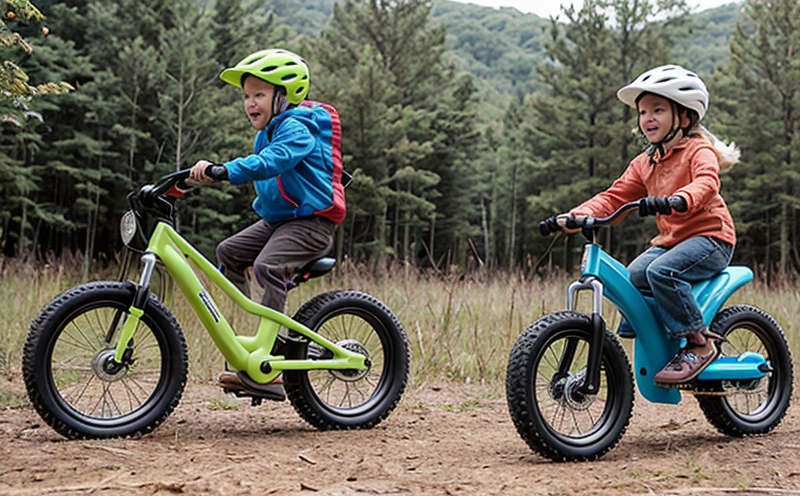ISO 8124-1 Ride-on Toy Push and Pull Strength Test
The ISO 8124 series of standards is internationally recognized as a comprehensive framework for ensuring the safety, durability, and quality of toys. Among these, ISO 8124-1: Mechanical strength tests for toys specifically addresses the mechanical aspects that ensure ride-on toys are safe for children to use.
The ISO 8124-1 standard encompasses various physical properties, including push and pull strength tests. These tests aim to evaluate how well a toy can withstand external forces such as pushing or pulling without breaking, thereby ensuring that children using these toys do not face the risk of injury from structural failure.
This test is particularly crucial for ride-on toys due to their inherent design which allows children to apply significant force through movement and play. The push and pull strength test ensures that parts like wheels, handles, and frames can endure the stress without compromising safety or integrity. Compliance with this standard demonstrates a commitment to high-quality toy manufacturing, thereby building consumer confidence.
The testing process involves attaching a calibrated load cell to the ride-on toy at specific points of application, depending on the design of the toy. The load is then gradually increased until the specimen fails either by breaking or losing its structural integrity. The test is performed under controlled environmental conditions to ensure accurate and repeatable results.
The primary objective of this test is not merely to meet regulatory requirements but to enhance product reliability, ensuring that toys can withstand normal use without failure. This is critical for ride-on toys as they are often subjected to rough handling by children who may be less gentle with their belongings. The standard also emphasizes the importance of using appropriate testing methods and instruments to ensure accuracy.
Compliance with ISO 8124-1 standards is a requirement in many countries, including the European Union (EU) and other regions that adopt international safety standards for toys. This compliance ensures not only legal adherence but also enhances brand reputation by demonstrating commitment to child safety.
Why Choose This Test
- The ISO 8124-1 standard is internationally recognized and widely adopted, ensuring global consistency in toy safety standards.
- This test specifically targets the mechanical strength of ride-on toys, addressing a critical aspect often overlooked by manufacturers.
- Compliance with this test can significantly reduce product liability risks by preventing accidents caused by structural failures.
- Enhanced Safety: Ensures that ride-on toys are robust enough to withstand the forces children apply during play, reducing the risk of injuries.
- Market Competitiveness: Demonstrates a commitment to quality and safety, enhancing brand reputation and market standing.
- Regulatory Compliance: Ensures that products meet strict international standards, thus avoiding potential legal issues in multiple markets.
Quality and Reliability Assurance
The ISO 8124-1 push and pull strength test plays a pivotal role in ensuring the quality and reliability of ride-on toys. By subjecting these toys to controlled stress conditions, manufacturers can identify potential weaknesses or design flaws early on in the development process.
Quality assurance through this testing involves not only meeting regulatory standards but also exceeding them where possible. This approach ensures that products are robust enough to withstand the rigors of everyday use by children. The test results provide valuable feedback for continuous improvement, allowing manufacturers to refine designs and materials for optimal performance.
Reliability in ride-on toys is crucial given their role as a primary source of play and exploration for young children. Ensuring that these toys can endure the physical demands placed upon them enhances user satisfaction and fosters trust between parents and manufacturers. The test results are also instrumental in certifying compliance with international safety standards, thereby ensuring legal compliance.
Moreover, the push and pull strength test is an integral part of a broader quality control strategy that includes regular inspections, material testing, and process validation. Together, these measures ensure that ride-on toys meet both functional and safety requirements, thus delivering products that are not only robust but also child-friendly.
Use Cases and Application Examples
| Use Case | Description |
|---|---|
| Ride-on Toy Manufacturing: | Manufacturers use this test to ensure that the mechanical components of ride-on toys, such as wheels and frames, can withstand the forces exerted by children during play. |
| Safety Compliance: | Regulatory bodies rely on these tests to verify compliance with international standards, ensuring that ride-on toys are safe for child use in various markets. |
| R&D and Innovation: | Testing helps R&D teams refine designs by identifying areas of potential improvement or redesign needed to enhance safety and durability. |
| Procurement: | Procurement teams use these test results to select suppliers who can consistently deliver products that meet the highest quality and safety standards. |
- Ride-on Toy Manufacturing: Ensures that all components are robust enough to withstand the physical demands of children during play. This includes wheels, handles, and frames.
- Safety Compliance: Demonstrates compliance with international standards such as ISO 8124-1, thereby ensuring legal compliance in various markets.
- R&D and Innovation: Provides valuable insights into product performance, helping teams identify areas for improvement. This can lead to enhanced safety features and innovative designs.
- Procurement: Helps procurement teams select suppliers who consistently deliver products that meet the highest quality and safety standards.





